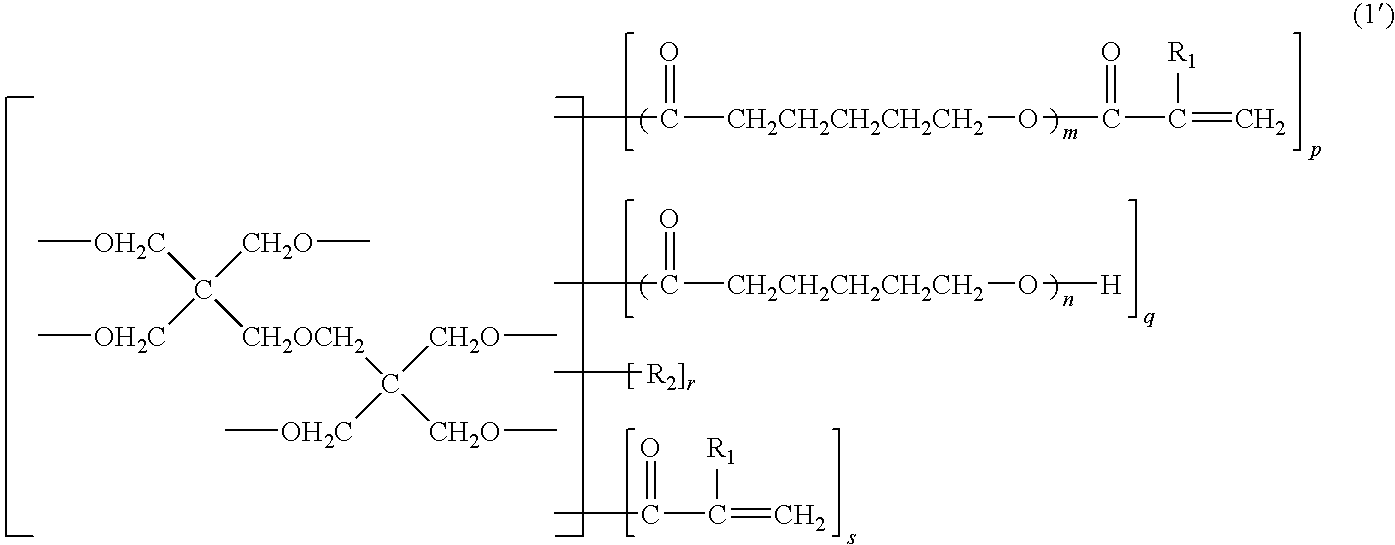Photosensitive resin composition, dry film, and processed product made using the same
a technology of resin composition and dry film, which is applied in the direction of photosensitive materials, instruments, photomechanical equipment, etc., can solve the problems of film produced from these materials, less flexible, and inability to be subjected to bending processing, and achieves good flame retardancy, enhances the productivity of printed wiring boards, and reduces the risk of putting a load on the environment.
- Summary
- Abstract
- Description
- Claims
- Application Information
AI Technical Summary
Benefits of technology
Problems solved by technology
Method used
Image
Examples
example 1
Synthesis of Polyimide Precursor
[0106]A 300 ml-separable was flask fitted with a stirrer, Dean-Stark trap, reflux condenser, 100 ml-dropping funnel, and nitrogen inlet. In a nitrogen atmosphere, the flask was charged with 93.3 g N-methylpyrrolidone (Tokyo Chemical Industry Co., Ltd.), 40.0 g mesitylene (Kanto Chemical Co., Inc.) and 60.8 g oxydiphthalic acid dianhydride (MANAC Incorporated). With stirring, 57.9 g amino-terminated polypropylene glycol (“JEFFAMINE D400” from Huntsman Corporation) was added dropwise in the flask over 1 hour. The internal temperature was raised to 180° C. After 8.5 hour-reflux at 180° C., the flask was cooled to room temperature. Thereafter, 15.9 g 1,3-bis(3-aminophenoxy)benzene (Mitsui Chemicals, Inc.) was added in the flask. Stirring was continued for 20 hours in a nitrogen atmosphere to produce a partially-imidized polyamic acid solution (polyimide precursor solution) with a solid content of 49 wt %.
[0107]Preparation of Photosensitive Resin Compositi...
example 2
Synthesis of Polyimide Precursor
[0113]A 300 ml-separable was flask fitted with a stirrer, Dean-Stark trap, reflux condenser, 100 ml-dropping funnel, and nitrogen inlet. In a nitrogen atmosphere, the flask was charged with 93.6 g N-methylpyrrolidone (Tokyo Chemical Industry Co., Ltd.), 40.1 g mesitylene (Kanto Chemical Co., Inc.) and 62.0 g oxydiphthalic acid dianhydride (MANAC Incorporated). With stirring, 50.4 g amino-terminated polypropylene glycol (“JEFFAMINE D400” from Huntsman Corporation) was added dropwise in the flask over 1 hour. The internal temperature was raised to 180° C. After 8.5 hour-reflux at 180° C., the flask was cooled to room temperature. Thereafter, 21.6 g 1,3-bis(3-aminophenoxy)benzene (Mitsui Chemicals, Inc.) was added in the flask. Stirring was continued for 20 hours in a nitrogen atmosphere to produce a partially-imidized polyamic acid solution (polyimide precursor solution) with a solid content of 49 wt %.
[0114]Preparation of Photosensitive Resin Compositi...
example 3
Preparation of Photosensitive Resin Composition
[0118]At 21° C., to 63.1 g polyimide precursor solution obtained as in Example 1 was added: 13.3 g condensate of dipentaerythritol and ε-caprolactone where all of the 6 terminal functional groups are esterified with an acrylic acid (“KAYARAD-DPCA60” from Nihon Kayaku Tokyo Co., Ltd.) and 11.8 g N,N′-dimethylacetoamide; as a photopolymerization initiator 0.5 g diethylthioxanthone (“KAYACURE-DETX-S” from Nihon Kayaku Tokyo Co., Ltd.); 1.1 g ethyl p-dimethylaminobenzoate (“KAYACURE-EPA” from Nihon Kayaku Tokyo Co., Ltd.); as a flame retardant 10.0 g hexa(phenoxy)cyclotriphosphazene (“SPE-100” from Otsuka Chemical Co., Ltd.); and 0.1 g phenylimidazole (“CUREZOL 2PZ-PW” from Shikoku Chemical Corporation). The mixture was stirred for 30 minutes to produce a brown viscous liquid with a viscosity of about 2 Pa□.
[0119]Production and Evaluation of Dry Film
[0120]The photosensitive resin composition obtained above was applied onto a polyethylene te...
PUM
| Property | Measurement | Unit |
|---|---|---|
| Percent by mass | aaaaa | aaaaa |
| Electrical resistance | aaaaa | aaaaa |
| Photosensitivity | aaaaa | aaaaa |
Abstract
Description
Claims
Application Information
 Login to View More
Login to View More - R&D
- Intellectual Property
- Life Sciences
- Materials
- Tech Scout
- Unparalleled Data Quality
- Higher Quality Content
- 60% Fewer Hallucinations
Browse by: Latest US Patents, China's latest patents, Technical Efficacy Thesaurus, Application Domain, Technology Topic, Popular Technical Reports.
© 2025 PatSnap. All rights reserved.Legal|Privacy policy|Modern Slavery Act Transparency Statement|Sitemap|About US| Contact US: help@patsnap.com



